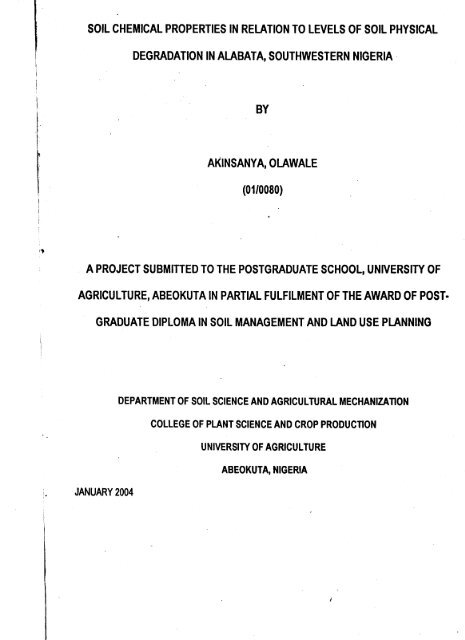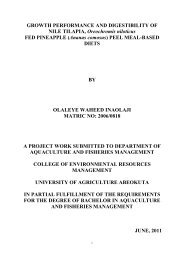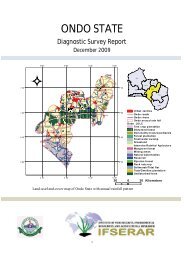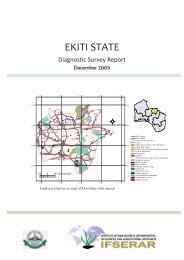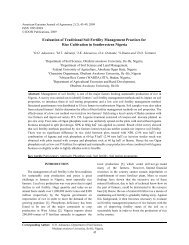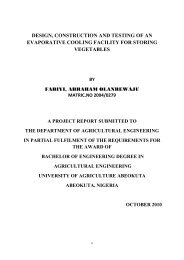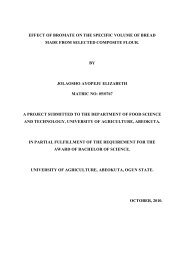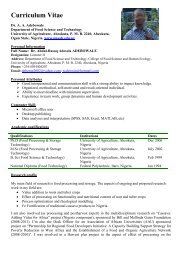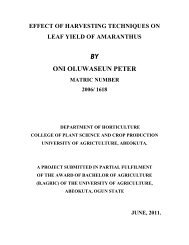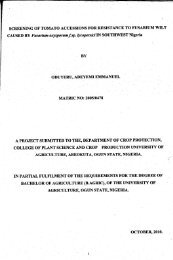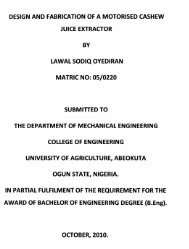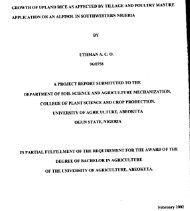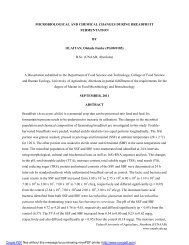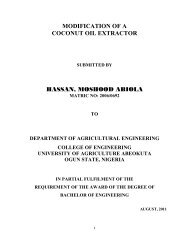akinsanya, olawale - The Federal University of Agriculture, Abeokuta
akinsanya, olawale - The Federal University of Agriculture, Abeokuta
akinsanya, olawale - The Federal University of Agriculture, Abeokuta
Create successful ePaper yourself
Turn your PDF publications into a flip-book with our unique Google optimized e-Paper software.
SOIL CHEMICAL PROPERTIES IN RELATION TO LEVELS OF SOIL PHYSICAL<br />
DEGRADATION IN ALABATA,<br />
SOUTHWESTERN NIGERIA·<br />
AKINSANYA, OLAWALE<br />
(01/0080)<br />
A PROJECT SUBMITTED TO THE POSTGRADUATE SCHOOL, UNIVERSITY OF<br />
AGRICULTURE, ABEOKUTA IN PARTIAL FULFILMENT OF THE AWARD OF POST·<br />
GRADUATE DIPLOMA IN SOIL MANAGEMENT AND LAND USE PLANNING<br />
DEPARTMENT OF SOIL SCIENCE AND AGRICULTURAL<br />
MECHANIZATION<br />
COLLEGE OF PLANT SCIENCE AND CROP PRODUCTION<br />
UNIVERSITY OF AGRICULTURE<br />
ABEOKUTA,<br />
NIGERIA
DECLARA liON<br />
I hereby declare that this dissertation<br />
has been written by me and is a record <strong>of</strong> my own research work.<br />
It has not been presented in any previous application for a higher degree <strong>of</strong> this or any other <strong>University</strong>.<br />
All citations and sources <strong>of</strong> information are clearly acknowledged<br />
by means <strong>of</strong> references.<br />
Akinsanya,<br />
Olawale.<br />
Date ~ .
his is to certify that this work, carried out by AKINSANYA, OLAWALE Department <strong>of</strong> Soil Science<br />
nd Agricultural Mechanization, <strong>University</strong> <strong>of</strong> <strong>Agriculture</strong>, <strong>Abeokuta</strong>, Nigeria under the supervision<br />
t<strong>of</strong> Dr. F.K. Salako meet the regulation governing the award <strong>of</strong> the degree <strong>of</strong> Post-Graduate<br />
,Diploma <strong>of</strong> the <strong>University</strong> <strong>of</strong> <strong>Agriculture</strong>. <strong>Abeokuta</strong>, Nigeria and is approved for its contribution to<br />
scientific knOWledgeand literary presentation.<br />
B. Agric., M.Sc. (Nig.), Ph.D. (Ibadan)<br />
Senior Lecturer in Soil Physics/Soil Conservation<br />
Dr. F. K. Salako<br />
Acting Head<br />
Department <strong>of</strong> Soil Science and Agricultural Mechanisation<br />
iii
ABSTRACT<br />
This study was carried out in 2002 at the <strong>University</strong> <strong>of</strong> <strong>Agriculture</strong>, Alabata, near <strong>Abeokuta</strong>,<br />
southwestern Nigeria ... It was part <strong>of</strong> two experiments established in 2001 on two previously<br />
degraded sites. Soil degradation processes were by soil erosion in Experiment 1 and by<br />
mechanization in Experiment 2. 80th experiments were randomized complete block designs with 3<br />
replications in Experiment 1 and 4 replications in Experiment 2. Treatments in Experiment 1 were<br />
levels <strong>of</strong> soil degradation, classified as fairly, moderately and severely degraded while flat<br />
(mechanical) and mound (manual) tillage practices were compared in Experiment<br />
2. Upland rice<br />
(ITA 150, ITA 321, WAS 189 and WAS 450) was the test crop in Experiment 1 and maize (Acr 86-<br />
TZESRW) was the test crop in Experiment 2. Clay in the fairly degraded soil was significantly higher<br />
than in the moderately degraded soil while the highest sand content was observed in the severely<br />
degraded soil. Although the soils were not chemically degraded, the coefficients <strong>of</strong> variation <strong>of</strong> soil<br />
chemical properties was up to 54% depending on the parameter. <strong>The</strong> wide variations among levels<br />
<strong>of</strong> soil degradation suggested that the fertility management <strong>of</strong> the soil would be difficult. Soil<br />
chemical properties between flat and manual tillage were not significantly different, and did not vary<br />
as much as in Experiment 1, suggesting that the previous mechanical and manual tillage practices<br />
had no significant residual effects on the soil chemical properties. This study showed that physical<br />
processes <strong>of</strong> soil degradation<br />
had varying effects on soil chemical properties, with soil erosion<br />
causing higher variation than tillage practices.<br />
Also, cultivation <strong>of</strong> different rice varieties influenced<br />
the variability observed.
DEDICATION<br />
iCated to God Almighty, who forever shall be and my children Akinwole,
ACKNOWLEDEMENT<br />
<strong>The</strong> Lord is good all the time in my life to make it possible for me to successfully complete this<br />
programme. So, I am very grateful to HIM for his guidance, provision and protection from my childhood<br />
and to this day.<br />
I am grateful to my supervisor<br />
Dr. F.K. Salako for his thorough guidance, aids and support,<br />
morally 'and financially, throughout this project work. May God in his infinite mercy continue to be your<br />
source <strong>of</strong> power.<br />
I further wish to show my gratitude to all the lecturers in Department<br />
<strong>of</strong> Soil Science and<br />
Agricultural Mechanization <strong>of</strong> the <strong>University</strong> for their encouragement and support, mosUy in the<br />
knowledge impacted on me.<br />
My special gratitude goes to my father Mr. 1.0. Akinsanya (JP) and Evang. C.A. Akinsanya who<br />
have been my source <strong>of</strong> encouragement<br />
morally and financially.<br />
I want to also appreciate my wife for her moral support for me during the period <strong>of</strong> this course<br />
<strong>of</strong> study.<br />
My sincere gratitude also goes to my younger brother Akintunde Oluwaseyi Akinsanya for his<br />
moral and financial assistance.<br />
I also show my special gratitude to Adeyemo 'Femi and Opabode 'Sina for their numerous<br />
support for me during the period <strong>of</strong> this course.
TABLE OF CONTENTS<br />
TITLE PAGE<br />
DECLARATION<br />
CERTIFiCATION<br />
i<br />
ii<br />
iii<br />
ABSTRACT " ,iv<br />
DEDiCATION , v<br />
ACKNOWLEDGEMENT<br />
vi<br />
TABLE OF CONTENTS vii-viii<br />
CHAPTER ONE<br />
1.0 INTRODUCTION 1-2<br />
CHAPTER TWO<br />
2.0 LITERATURE REViEW J<br />
2.1 SOIL DEGRADATION AND REHABILITATION 3 - 4<br />
2.2 SOIL MANAGEMENT IN THE TROPICS 5 - 6<br />
2.3 CEREAL PRODUCTION IN THE TROPICS 6<br />
CHAPTER THREE<br />
3.0 MATERIALS AND METHODS<br />
3.1 SITES 7 - 8<br />
3.2 SOIL SAMPLING 9<br />
3.3 LABORATORY ANALYSIS 10 -12<br />
3.4 DATA ANALYSIS 12
CHAPTER FOUR<br />
4.0 RESULT<br />
·~·t·. RICE PLOT 13·20<br />
CHAPTER FIVE<br />
5.0 DISCUSSiON 30 - 31<br />
REFERENCES 33-37<br />
.:·,~OIX 38 -44<br />
--
INTRODUCTION<br />
Nutrient depletion <strong>of</strong> weakly structured tropical soils through long-term cultivation without<br />
supplementary addition <strong>of</strong> nutrients and inappropriate tillage practices are major problems on arable<br />
land in West Africa (Kirchh<strong>of</strong> and Salako, 2000). In the process <strong>of</strong> degradation, the capacity <strong>of</strong> the soil to<br />
produce enough food to meet the expectation <strong>of</strong> farmers reduces.<br />
Rice and maize are part <strong>of</strong> the major cereal crops that tolerate most warm conditions as found<br />
in southwestern Nigeria. <strong>The</strong> crops are grown for their grains on a wide variety <strong>of</strong> soils in the tropics,<br />
ranging from sand to heavy clay. <strong>The</strong>se grain crops do not sustain their yields after prolonged cultivation<br />
on a piece <strong>of</strong> land (Lal, 1997a, 1997b). Due to pressure on available arable land, farmers use land for<br />
continuous cultivation without necessary inputs for sustainable production. So in the tropics, particularly<br />
Africa, it is important to evaluate changes in soil properties under prolonged or continuous cultivation <strong>of</strong><br />
land.<br />
<strong>The</strong> fertility <strong>of</strong> the soil is controlled by its pH, exchangeable bases and cation exchangeable capacity<br />
(CEC). <strong>The</strong>se affect the retention <strong>of</strong> plant nutrients that are available to the plant, thereby reducing crop<br />
nutrient uptake and performance. Most tropical soils are highly weathered, acidic and very low in cation<br />
exchangeable capacity, hence reducing the exchangeable cations in the soil (Sanchez, 1976 and Igwe<br />
et al,1995). Low fertility <strong>of</strong> the soil is caused by prolonged cultivation without nutrient replenishment. <strong>The</strong><br />
soils contain mostly the 1:1 non-expanding kaolinite clay minerals, aluminum and iron oxides. <strong>The</strong>se are<br />
described as low activity clay (LAC) by Harris et al,1996 and Lal, 1985.Thus, the soils hold water and<br />
nutrients marginally, and are highly susceptible to water erosion. After two or three years <strong>of</strong> cultivation,<br />
soil productivity steeply declines.
...<br />
-Soil chemical properties <strong>of</strong> an Alfisol at different levels <strong>of</strong> degradation under rice cultivation<br />
,~ohemical<br />
....... -<br />
-: ;.<br />
properties <strong>of</strong> a previously cultivated soil in relation to mechanical and manual tillage using
CHAPTER TWO<br />
LITERATURE REVIEW<br />
2.1 SOIL DEGRADATION AND REHABILITATION<br />
Soil degradation processes are phenomena that cause a decrease in the quality <strong>of</strong> soils and<br />
can be divided into three interactive groups: physical, chemical and biological degradation. However<br />
the primary soil degradative process is physical (Moorman and Greenland, 1980). <strong>The</strong> most<br />
common land degradation is due to improper land management that can cause soil erosion. Most<br />
farmers do not use proper soil conservation and management practices.<br />
Soil degradation decreases the potential capability <strong>of</strong> soil to produce goods and services. It could<br />
have occurred due to continuous cultivation, but may also occur over a short period if soils are not<br />
properly managed, especially with high rainfall erosivity, which is characteristic <strong>of</strong> the tropics.<br />
EI-Swaify (1998) observed processes <strong>of</strong> soil degradation to include soil erosion and nutrient<br />
depletion, which are accelerated by demographic pressure. However, the definition <strong>of</strong> a degraded<br />
land is elusive because there are various levels <strong>of</strong> soil degradation and different satisfactory levels<br />
<strong>of</strong> soil rehabilitation depending on intending land use after the rehabilitation program (Barrow, 1991;<br />
Harris et aI., 1996). Soil physical degradation in tropical Alfisol occurs during initial forest clearing<br />
before cultivation commences and it is <strong>of</strong>ten due to raindrop impact on the exposed soils (Lal,<br />
1976). Mechanical, human and animal traffic can compact this soil, reducing its capacity to produce<br />
crops (Ghuman and Lal, 1991a; Ghuman et ai, 1991; Lal, 1992). Cultivated lands may not be<br />
degraded depending on the soil management practices adopted by farmer. In this respect, it has to<br />
be emphasized that a previously cultivated land may not be degraded because the productive<br />
capacity <strong>of</strong> the land for a suitable crop may still be adequate.<br />
3
Productivity <strong>of</strong> severely degraded soils may not be restored on a human time scale<br />
Johnsonand Bradshaw, 1979), especially in highly populated countries where production and pr<strong>of</strong>it<br />
goalsprevail over environmental concern. In southwestern Nigeria, farmers cultivate sites that are<br />
predisposedto erosion by steep slopes and they would not adopt soil conservation measures if it is<br />
expensiveor n~t in tune with their cultural practices (Ekanade, 1997). Such practices render soils<br />
severely degraded and one consequence <strong>of</strong> this is the transformation<br />
<strong>of</strong> forests to derived<br />
savannah.Plinthite or its related forms are hardened and cemented after exposure by soil erosion in<br />
thetropics, resulting in barren land (Eswaran et ai, 1990) or a derived savanna in once forested<br />
agroecological zone like some parts <strong>of</strong> southwestern Nigeria.<br />
Degraded soils are structure less and fragile in nature (Oldeman, 1990; 1994). <strong>The</strong>y are<br />
exposedto erosion by water and may have their topsoil washed away. Greenland (1977) found that<br />
thestructures <strong>of</strong> topsoil are more prone to deterioration under raindrop impact so it should be given<br />
muchattention. In the soil, root growth is either slowed down or prevented depending on the level <strong>of</strong><br />
compaction. Suwardjo et al (1991) reported that land degradation is a serious problem in upland<br />
agriculture. It is caused by such activities such as shifting cultivation, erosion, improper land use,<br />
land clearing, etc. Accelerated erosion is also a major factor responsible for soil fertility depletion<br />
and a decline in productivity <strong>of</strong> soils in the tropics (Mohammad and Gumbs, 1982).<br />
Land restoration is the process by which a degraded land is returned to its original state (Harris et<br />
ai, 1996). Natural fallow has been an age-long practice for restoration <strong>of</strong> soil productivity in the<br />
tropics (Aweto, 1981). Whether or not true rehabilitation can ever be fully achieved is a vexed<br />
q~~stion because natural systems may change with time and the scale the system is examined will<br />
affect observations.
2.2 SOIL MANAGEMENT IN THE TROPICS<br />
Soil productivity encompasses biological, physical and chemical fertility. Farmers in the tropics were<br />
able to judge soils productivity based on indigenous knowledge gathered from cropping systems and<br />
crop yields (Ishida and Tian, 2001). Often, it is easier to improve soil chemical fertility through addition <strong>of</strong><br />
organic and inorganic nutrients than to improve physical and biological fertility. However, use <strong>of</strong><br />
inorganic fertilizers is costly for resource-poor farmers in the tropics Inoganic fertilizer recommendations<br />
in the tropics require caution because some fertilizers degrade the soil through acidification, although<br />
the right use <strong>of</strong> inorganic fertilizers usually boost crop production substantially (Juo et aI., 1995a; 1995).<br />
Organic manure is equivalent to chemical fertilizer in terms <strong>of</strong> soil improvement (Tanaka, 1975;Yamane,<br />
1974). Cooke (1982) reported that fresh poultry dropping contained twice as much phosphorus as some<br />
inorganic fertilizers<br />
Manure increases organic matter content, water content and water movement in soil. It also results in<br />
reducing soil bulk density thereby reducing compaction and increasing crop-rooting depth.<br />
Soil physical properties can be improved or sustained using management practices, which include<br />
manual clearing, residue mulch, use <strong>of</strong> organic manure, cover cropping and alley cropping (Akobundu,<br />
1980; Tian and Kang, 1998; Kang et m. 1999; Kirchh<strong>of</strong> and Salako, 2000). <strong>The</strong>se systems are<br />
potentially sustainable. Also, yields can be improved by cultivating land with appropriate cropping<br />
intensities (Kang et m, 1990).<br />
In spite <strong>of</strong> the improvement <strong>of</strong> soil properties by herbaceous legumes such as Mucuna and<br />
Crotalaria. farmers in the tropics prefer gowing fopd legumes such as cowpea (Kirchholf and Salako,<br />
2000), primarily for economic gains. For instance, Mucuna cover cropping has been adopted in recent<br />
years by farmers in southern Benin republic, (Manyong et m, 1996), not because <strong>of</strong> soil conservation<br />
5
and fertility management consideration only, but because <strong>of</strong> reduced labour for weed control.<br />
Conservation @age, which includes minimum tillage or no tillage with incorporation or residue<br />
mulch/cover cropping is an aspect <strong>of</strong> soil management that can guarantee sustainable crop production<br />
in the tropics (Lal, 1997a; 1997b). Previously cultivated lands may not necessarily be degraded if<br />
sustainable crop production practices were adopted.<br />
2.3. CEREAL PRODUCTION IN THE TROPICS<br />
Maize (Zea mays, L.) thrives well in the tropics but its production can be boosted further by provision <strong>of</strong><br />
nutrients and appropriate soil management practices in a given environment. According to David and<br />
Adam (1985), maize is one <strong>of</strong> the world most important cereal crops. Maize is usually grown on wellstructured<br />
soils <strong>of</strong> intermediate texture (sandy loams to loams). Maize can be cultivated by conventional<br />
tillage, minimum tillage or zero tillage. Farmers are intensively using land for continuous cultivation with<br />
none or few input. So in the tropics, particularly Africa, it is important to evaluate the changes in soil<br />
properties as a result <strong>of</strong> continuous cultivation <strong>of</strong> the land.<br />
Rice (Oryza'sativa) is very important as a staple food and an economic crop in many countries. It is both<br />
indigenous and exotic crop in Africa. Rice production is concentrated in Asia where more than 90% <strong>of</strong><br />
the world supply is concentrated (FAO, 1981). Farmers cultivate rice in Africa mostly by depending on<br />
the natural rise and fall <strong>of</strong> streams and shallows swamps to flood the crop, and in the upland on rainfall<br />
to provide with ad~quate moisture.
CHAPTER THREE<br />
MATERIALS AND METHODS<br />
3.1. SITE<br />
<strong>The</strong> study was conducted under an experiment, which was established in 2001 (Salako F.K,<br />
personal communication) at the <strong>University</strong> <strong>of</strong> <strong>Agriculture</strong>, Alabata road, <strong>Abeokuta</strong> (Latitude 7.1 North<br />
and Longitude 3.3 East), southwestern Nigeria. Annual Rainfall is averagely 1200 mm and it has a<br />
bimodal distribution. <strong>The</strong> vegetation is a derived savannah and soil type is an Alfisol. Two<br />
experimental sites were used for the research work~<br />
3.1.1. EXPERIMENT 1: RICE PLOT<br />
This site was under about 3 years <strong>of</strong> fallow by 2001, after being abandoned due to low productivity<br />
(Salako F. K., personal<br />
communication).lt was at various levels <strong>of</strong> physical degradation and this<br />
was visible from the phases <strong>of</strong> soil eroson indicated by exposure <strong>of</strong> stones, gravel and boulders<br />
(Fig. 1). Gravel concentration is usually high in the B horizons <strong>of</strong> these Alfisols (Salako et aI., 1999)<br />
and could only have been exposed at the surface by erosion <strong>of</strong> the topsoil.<br />
Columns were<br />
demarcated into three levels depending on visually observed gravel concentration, although<br />
laboratory tests were used to further support the divisions.<br />
Three levels <strong>of</strong> soil degradation by soil erosion process were classified along the slope.<br />
<strong>The</strong>se were fairly degraded, moderately degraded and severely degraded.<br />
Subsequent agronomic<br />
yield showed that this delineation was right.<br />
A randomized complete block design was used. Plot<br />
size was 4 x 3 m. Four rice varieties were grown under poultry and NPK (20: 10: 10) application in<br />
2001 and 2002. <strong>The</strong> rice varieties were ITA 150, ITA 321, WAB189 B-B-B-8-HB and
REPl<br />
~<br />
>.-<br />
.!:: 3:<br />
co 0<br />
LL .0<br />
IREPl<br />
~
WAS450. Poultry manure was applied at 15 t ha- 1 and fertilizer N was at 80 kg N ha- 1 . Crop<br />
growth and yield for ITA 150 and WAS 189 grown on this site in 2001 were described by Uthman<br />
(2002). <strong>The</strong> variety, WAS 189 yielded 1.3 Uha while ITA 150 yielded 0.6 Uha paddy rice.<br />
<strong>The</strong> site was located on the lower part <strong>of</strong> a slope that had been mechanically cultivated for about<br />
three, years, prior to this study.<br />
Also, adjacent to this strip <strong>of</strong> mechanically cultivated strip, was a<br />
strip <strong>of</strong> manually tilled plots with mound. <strong>The</strong> mechanically cultivated soil was more compact than<br />
the manually tilled plot. Thus, the present experiment was imposed on these two existing land uses<br />
to have flat tillage with hoe on the mechanically tilled strip and re-built mounds on the mounded strip<br />
in 2001. <strong>The</strong> site was demarcated into 40 plots, each <strong>of</strong> which measured 5 m x 4 m. Randomized<br />
block design was used with 4 replicates. <strong>The</strong> fertility management included the application <strong>of</strong> poultry<br />
manure that was applied at the rate <strong>of</strong> 15 t ha- 1 and NPK (20:10:~was applied t have 80 kg N ha- 1 .<br />
Mucuna pruriens was planted as a cover crop. Preparation <strong>of</strong> the land for the second year <strong>of</strong><br />
cropping commenced in April 2002. Maize (Acr86TZESRW) was also planted in April 2002, at a<br />
spacing <strong>of</strong> 100 cm x 25 em.<br />
Soil samples used for this study were collected from the topsoil (0-15cm) using soil auger for the 72<br />
plots on the rice field and the 40 plots on the maize field. <strong>The</strong> sampling was done after harvesting<br />
rice and maize in 2002.<br />
<strong>The</strong> samples were air-dried for 72 hours and sieved using less than 2mm<br />
sieve size for particle size and cation analyses. Samples less 0.05 mm were used for organic<br />
carbon determination.
3.3. LABORATORY ANALYSIS<br />
3.3.1. SOIL PARTICLE SIZE ANAL YSIS<br />
This was done using the Bouyoucos (Hydrometer) method, which relies on the effects <strong>of</strong> particle size on<br />
the differential settling velocities within a water column. Fifty grammes <strong>of</strong> air-dried soil (were placed into<br />
a 400ml beaker. <strong>The</strong> soil was saturated with distilled water with 10 ml <strong>of</strong> 10% Calgon solution added<br />
and allowed to stand for 10 minutes.<br />
<strong>The</strong> Calgon treated soil was transferred into the dispersing cup and made to the mark on the cup with<br />
distilled water 100ml). <strong>The</strong> suspension was stirred for 2 minutes with electric high-speed stirrer before it<br />
was transferred into a graduated measuring cylinder and remaining soil was rinsed into the cylinder with<br />
distilled water. <strong>The</strong> solution was made up to 1000 ml and stirred within the cylinder. Hydrometer was<br />
then inserted into the suspension. At 40 seconds hydrometer reading <strong>of</strong> the suspensions was made.<br />
After two hours, both hydrometer readings were taken again. Room temperatures were recorded during<br />
each reading. <strong>The</strong> readings taken at 40seconds were assigned to the sand content and the readings at<br />
two hours assigned to clay content <strong>of</strong> the original suspension. <strong>The</strong> percentage silt was calculated as a<br />
difference between 100 and sum <strong>of</strong> sand and clay.<br />
3.3.2. SOIL pH<br />
Soil pH was determined in soil: water ratio <strong>of</strong> 1:2 (Henderson and Lalende, 1993). A 10-g<br />
sample was placed in a 50 ml plastic shaking bottle. <strong>The</strong>n 20 ml <strong>of</strong> distilled water was added to each<br />
sample. <strong>The</strong> bottles containing the samples were shaken for 30 min. with an electric shaker and were<br />
allowed to stand for about 15 min. <strong>The</strong> electrode <strong>of</strong> the pH meter was immersed in each <strong>of</strong> the settled<br />
suspension and the values <strong>of</strong> the soil pH were determined from the meter.<br />
10
3.3.3. SOIL ORGANIC CARBON<br />
Organic carbon was determined using a procedure described by Walkey and Black (1934)<br />
and modified by Allison (1965).<br />
One gram <strong>of</strong> air-dried soil lesser than 0.5 mm diameter was<br />
weighed into ~ach 500 ml flask from each sample. <strong>The</strong>n 10 ml <strong>of</strong> 1N potassium dichromate<br />
(K2Cr207)was added into the flask and concentrated sulphuric acid was added to the solution. <strong>The</strong><br />
solution was allowed to cool for 20 min. <strong>The</strong>n 100 ml <strong>of</strong> distilled water was added and followed by 5<br />
drops <strong>of</strong> ferroin indicator. <strong>The</strong> solution was then titrated with 0.5M ferrous sulphates to get the end<br />
point. A blank titration was also carried out.<br />
<strong>The</strong> organic carbon value was calculated as:<br />
% Organic carbon = (a-b) x 0.5 xO.003x 100 x f.<br />
a = ml <strong>of</strong> Fe2S04 in blank solution<br />
b = ml <strong>of</strong> Fe2S04 in soil solution<br />
f = Titration factor (77% or 1.33)<br />
Percentage <strong>of</strong> soil organic matter was calculated by multiplying carbon percentage with<br />
3.3.4. EXCHANGEABLE BASES IN SOIL<br />
<strong>The</strong> soil samples (5g each) were extracted with an excess <strong>of</strong> 1M NH40Ac (Ammonium<br />
acetate) solution such that the maximum exchange occurred between the NH4 and the cations<br />
originally occupying exchange sites on the soil surface. <strong>The</strong> amounts <strong>of</strong> exchangeable sodium,<br />
potassium, calcium and magnesium in the extracts were determined by flame photometry (Na and<br />
K) and by atomic absorption spectrometry (Ca and Mg)<br />
11
3.3.5. EXTRACTABLE PHOSPHORUS<br />
Phosphorus was extracted using Bray-1 extractant. This was done by weighing 5 g <strong>of</strong> airdried<br />
soil into extraction cups into which 30ml <strong>of</strong> Bray-1 extractant solution was added. Treated<br />
samples were transferred into the auto analyzer cups to read P content <strong>of</strong> soil<br />
3.4. DATA ANALYSIS<br />
<strong>The</strong> results <strong>of</strong> the chemical analysis were analyzed using the generalized linear model (SAS, 1988)<br />
and means were separated using least significant difference (LSD) at P=O.05.
CHAPTER<br />
FOUR<br />
RESULTS<br />
4.1. RICE CULTIVATION AT DIFFERENT LEVELS OF SOIL DEGRADATION<br />
4.1.1. PARTICLE SIZE DISTRIBUTION<br />
<strong>The</strong> sand contents in the severely and moderately degraded soils (Fig. 1) were not significantly<br />
different (Table 1). However both had significantly higher sand content than the fairly degraded soil. For<br />
the silt content, the fairly degraded strip had the highest amount <strong>of</strong> silt whereas the severely degraded<br />
strip had the least silt content. <strong>The</strong>re was a significant difference in clay contents <strong>of</strong> the fairly degraded<br />
and moderately degraded levels. Silt and clay varied more than sand under rice cultivation with the<br />
coefficient <strong>of</strong> variation for sand being less than 5% while up to 80% was observed for clay (Table 2).<br />
4.1. 2. SOIL ACIDITY, ORGANIC MATTER AND EXTRACTABLE PHOSPHORUS<br />
<strong>The</strong> soils were acidic with significant differences in pH between the severely degraded site and<br />
other levels <strong>of</strong> degradation (Table 3). Exchangeable acidity was, however similar among the various<br />
levels <strong>of</strong> soil degradation while organic matter content in the moderately degraded stirp was significantly<br />
lower than those observed in the severely degraded strips. Phosphorus in the moderately degraded site<br />
was significantly higher than P contents <strong>of</strong> the fairly degraded and severely degraded strips (Table 3).<br />
<strong>The</strong> coefficients <strong>of</strong> variation were less than 10% for pH. However coefficient <strong>of</strong> variation were generally<br />
higher than 10% in organic matter and good level <strong>of</strong> fluctuation in the variability <strong>of</strong> extractable P<br />
(Table 4).
TABLE 1: EFFECT OF DEGRADATION ON SOIL PARTICLE SIZE ANALYSIS.<br />
Particle size distribution (glkg)<br />
Level <strong>of</strong> degradation<br />
Sand<br />
Silt<br />
Clay<br />
Fairly degraded<br />
800<br />
193<br />
27
TABLE 2:<br />
VARIATION IN PARTICLE SIZE DISTRIBUTION UNDER VARIOUS RICE VARIETIES<br />
AT DIFFERENT LEVLES OF DEGRADATION<br />
Coefficients <strong>of</strong> variation (%)<br />
Level <strong>of</strong> degradation Sand Silt Clay<br />
ITA 150<br />
Fairly degraded 1 4 4<br />
Moderately degraded 4 19 1<br />
Severely degraded 2 17 2<br />
ITA 321<br />
Fairly degraded 4 17 1<br />
Moderately degraded 1 5<br />
Severely degraded 2 10 31<br />
WAB 189<br />
Fairly degraded 2 15 70<br />
Moderately degraded 3 20 80<br />
Severely degraded 2 13<br />
WAB 450<br />
Fairly degraded 3 10 29<br />
Moderately degraded 10 9<br />
Severely degraded
TABLE 3: SURFACE SOIL (O-15CM) ACIDITY, ORGANIC MAnER<br />
AND EXTRACTABLE P ON<br />
THE DEGRADED ALFISOL<br />
Soil chemical properties<br />
Organic<br />
Extractable<br />
Level <strong>of</strong> degradation pH (1:1 H2O) H+ matter (%) P (mg/kg)<br />
Fairly degraded 5.66 0.086 5.39 2.14<br />
Moderately degraded 5.63 0.084 3.67 2.41<br />
Severely degraded 5.58 0.082 4.42 2.11<br />
LSD (0.05) 0.13 NS 1.19 0.17
TABLE 4: VARIATION IN SOIL ACIDITY, ORGANIC MATTER CONTENT AND EXTRACTABLE P<br />
DISTRIBUTION UNDER VARIOUS RICE VARIETIES AT DIFFERENT LEVLES OF<br />
DEGRADATION<br />
Coefficients <strong>of</strong> variation (%)<br />
Organic<br />
Level <strong>of</strong> degradation pH matter Extractable P<br />
ITA 150<br />
Fairly degraded 2.87 12.80 14.63<br />
Moderately degraded 2.68 34.32 15.27<br />
Severely degraded 2.22 53.54 6.38<br />
ITA 321<br />
Fairly degraded 0.09 31.09 4.46<br />
Moderately de'graded 1.90 52.08 25.28<br />
Severely degraded 2.22 48.16 3.93<br />
WAB 189<br />
Fairly degraded 4.18 30.36 9.34<br />
Moderately degraded 3.07 18.92 14.68<br />
Severely degraded 0.69 18.27 2.70<br />
WAB 450<br />
Fairly degraded 1.25 44.68 10.9<br />
Moderately degraded 5.48 31.90 1.72<br />
Severely degraded<br />
- Not determined<br />
17
4.1.3: SOfL CAnONS CONTENT<br />
Potassium (K) content reveals no significant difference in all the levels <strong>of</strong> degradation, while<br />
Exchangeable Calcium (Ca) in the moderately degraded soil was significantly different from the severely<br />
degraded fraction, which is higher in quantity. Exchangeable Magnesium (Mg) content was not<br />
significantly' different between the various degradation levels. <strong>The</strong> soil sodium (Na) content for fairly<br />
degraded fraction was<br />
significantly higher to severely degraded soil (Table 5). Crop nutrients<br />
requirement from sandy soils benefit more from regular and generous application <strong>of</strong> organic and<br />
inorganic fertilizer than organic matter stock <strong>of</strong> the soil because <strong>of</strong> erosion. <strong>The</strong> depletion <strong>of</strong> fine<br />
materials by erosion may also be the cause <strong>of</strong> the low level <strong>of</strong> organic matter.<br />
<strong>The</strong> higher cations concentration in the fairly degraded soil suggests that there was less<br />
leaching or erosion <strong>of</strong> nutrients from the surface soil compared to the moderately and severely<br />
degraded site. <strong>The</strong> Sodium (Na) content was however very low that even the relatively high content<br />
would not cause salinity problem. <strong>The</strong> acidic pH level has already indicated this.<br />
<strong>The</strong> Coefficients <strong>of</strong> Variation (CV) suggest that soil management for replenishment <strong>of</strong> organic<br />
matter and phosphorus, Calcium (Ca), Magnesium (Mg) and Potassium (K) will be very difficult for rice<br />
as these did not just vary with level <strong>of</strong> soil degradation, but also with the rice variety cultivated.
TABLE 5: SURFACE SOIL (0-15CM) CATION CONTENT IN THE VARIOUS LEVELS OF<br />
DEGRADATION ON THE DEGRADED ALFISOL.<br />
Mg<br />
0.67
TABLE 6: VARIATION IN RICE VARIETIES AND SOIL EXCHANGEABLE CATIONS AT<br />
DIFFERENT LEVLES OF SOIL DEGRADATION<br />
Coefficients <strong>of</strong> variation (%)<br />
Level <strong>of</strong> degradation K Ca Mg Na<br />
ITA 150<br />
Fairly degraded 6.67 19.16 32.00 19.17<br />
Moderately degraded 12.5 16.67 26.00 19.48<br />
Severely degraded 54.17 15.04 40.00 21.65<br />
ITA 321<br />
Fairly degraded 5.00 20.75 12.7 55.00<br />
Moderately degraded 6.36 40.75 1.20 42.86<br />
Severely degraded 10.51 23.87 16.30 4.55<br />
WAB 189<br />
Fairly degraded 59.26 18.94 36.51 20.83<br />
Moderately degraded 10.0 20.69 33.33 18.07<br />
Severely degraded 0.00 15.67 10.0 23.10<br />
WAB 450<br />
Fairly degraded 17.08 28.49 16.44 78.26<br />
Moderately degraded 9.52 16.00 8.47 12.00<br />
.Severely degraded<br />
-Not determined
4.2. MAIZE CULTIVATION IN RELATION TO TILLAGE ON A PREVIOUSLY DEGRADED<br />
ALFISOL<br />
4.2.1. PARTICLE SIZE DISTRIBUTION<br />
<strong>The</strong>re was no significant difference in the soil particle fractions under the two tillage practices for<br />
maize cultivation in 2002 (Table 7). Though the dominance <strong>of</strong> sand was prominent as part <strong>of</strong> the soil<br />
forming processes (e.g. eluviations), soil erosion causing removal <strong>of</strong> finer particles also contributed<br />
to it. <strong>The</strong> low content <strong>of</strong> clay and silt showed high depletion <strong>of</strong> fine materials by soil erosion. With<br />
this low clay content the field would be low in cation exchange capacity as well as structural stability.<br />
It would however appear that surface soils <strong>of</strong> alfisols in southwestern Nigeria are generally high in<br />
sand content (Salako and Hauser, 2001).<br />
<strong>The</strong>re was also significant difference in the pH <strong>of</strong> the two tillage practices. <strong>The</strong> pH <strong>of</strong> the site being<br />
weakly acidic pointed out that the experimental site is low in cations (table 8). <strong>The</strong>re was no<br />
significant difference in the organic matter content <strong>of</strong> the soils <strong>of</strong> the two tillage practices. <strong>The</strong> low<br />
pH and organic matter were probably due to the continuous cropping <strong>of</strong> the soils and insufficient<br />
recycling <strong>of</strong> plant and nutrients (Okeleye and Adetunji, 1998).<br />
<strong>The</strong> chemical degradation has depleted much <strong>of</strong> the topsoil's cations and the soil is being rendered<br />
. acidic. <strong>The</strong> organic matter content was low, which agrees with Davies et m, (1993) description <strong>of</strong><br />
organic matter levels <strong>of</strong> arable sandy soils. According to David et m (1989), organic matter <strong>of</strong><br />
tropical soils is dynamic due to climatic changes, which cause forming, and disruption <strong>of</strong> soil<br />
aggregates.
TABLE 7: PARTICLE SIZE DISTRIBUTION UNDER DIFFERENT TILLAGE PRACTICES AND<br />
MAIZE CULTIVATION AFTER LAND DEGRADATION IN ALABATA, ABEOKUTA,<br />
SOUTHWESTERN NIGERIA<br />
Particle size distribution (glkg)<br />
Tillage Sand Silt Clay<br />
Flat 871 118 11<br />
Mound 774 114 12<br />
LSD (0.05) NS NS NS<br />
NS = No significant difference
TABLE 8: SOIL ACIDITY, ORGANIC MAnER<br />
CONTENT AND AVAILABLE P UNDER DIFFERENT<br />
TILLAGE PRACTICE.<br />
Tillage pH Organic matter Extractable P<br />
Flat till 5.72 3.66 2.96<br />
Mound 5.67 3.73 2.72<br />
LSD (0.05) 0.041 NS<br />
,<br />
NS
<strong>The</strong>re was no significant difference in the soil particle size analysis for all the treatments <strong>of</strong> fertility<br />
management (table 9). Particle size distribution <strong>of</strong> the surface soil was similar for the three fertility<br />
management treatments.<br />
<strong>The</strong> textural analysis <strong>of</strong> the soils revealed that the soil was sandy loam with pH <strong>of</strong> 5.69 with no<br />
significant difference in the treatments showing that the soil is slighUy acidic (table 10). <strong>The</strong>se<br />
chemical properties indicate the inherent low fertility status <strong>of</strong> the soil due to the presence <strong>of</strong> low<br />
activity clay (Lal, 1992). <strong>The</strong>re is no significant difference in the low organic matter content <strong>of</strong> the<br />
soils. <strong>The</strong> predominance <strong>of</strong> sand and gravel in particle size distribution and low organic carbon<br />
showed that the soil structure would be weak. <strong>The</strong> available Phosphorus content shows no<br />
significant difference, though it is very low.
Particle size analysis (g/Kg)<br />
Fertility management Sand Silt Clay<br />
None 871 119 10<br />
Poultry 874 114 12<br />
Mucuna 874 114 12<br />
LSD (0.05) NS NS NS
TABLE 10: INTERACTION OF FERTILITY MANAGEMENT WITH SOIL ACIDITY, ORGANIC MATTER<br />
AND AVAILABLE<br />
P<br />
Fertility management pH Organic matter Extractable P<br />
None 5.69 3.72 2.85<br />
Poultry 5.69 3.70 2.95<br />
Mucuna 5.96 3.70 2.62<br />
LSD (O.OS) NS NS NS
<strong>The</strong> coefficient <strong>of</strong> variation were less than 10% in all the parameters puts into consideration<br />
except in clay content <strong>of</strong> the soil having high coefficient <strong>of</strong> variability which was as high as 53%<br />
(Table 11). This level <strong>of</strong> variability in clay indicates that soil management for the replenishment <strong>of</strong><br />
the exchangeable cations and other soil inherent properties for productivity will be very difficult<br />
despite the level <strong>of</strong> tillage adopted.
TILLAGE AND FERTILITY MANAGEMENT.<br />
Coefficients <strong>of</strong> variation (%)<br />
Fertility management Sand Silt Clay<br />
Flat<br />
N
SOIL ACIDITY, ORGANIC MAnER<br />
AND AVAILABLE P<br />
Coefficients o~variation (%)<br />
Fertility management PH Organic matter Extractable P<br />
Flat<br />
None 0.88 0.54 1.64<br />
Poultry 0.35 1.40 4.83<br />
Mucuna 0.00 0.54 0.00<br />
Mound<br />
None 1.06 5.37 12.55<br />
Poultry 0.88 4.79 12.64<br />
Mucuna 1.06 4.85 7.43
CHAPTER<br />
FIVE<br />
DISCUSSION<br />
<strong>The</strong> differences observed in particle size distribution according to the levels <strong>of</strong> degradation (Table 1)<br />
were due to selective erosion <strong>of</strong> soil particles by run<strong>of</strong>f. <strong>The</strong> severely degraded site had lost most <strong>of</strong><br />
its fine particles while these were still retained more on the fairly and moderately degraded strips.<br />
<strong>The</strong> texture <strong>of</strong> ~oil, derived from the particle size distribution, determines the potential ability <strong>of</strong> a soil<br />
to influence crop performance. According to Wild (1993), sandy soils are light and low in nutrient<br />
holding capacity. Ross (1989) stated further that sandy soils are porous and highly vulnerable to<br />
leaching and run-<strong>of</strong>f. Thus, sandy soils are infertile and make fertilizer use inefficient. <strong>The</strong><br />
implication <strong>of</strong> this is that more expenditure in terms <strong>of</strong> agricultural inputs will be required to<br />
rehabilitate a degraded site. <strong>The</strong> coefficients <strong>of</strong> variation for particle size distribution showed that<br />
fine particles (silt + clay) would play a critical role in response <strong>of</strong> these soils to management<br />
practices as they varied more than sand. More variation was observed under WAS varieties<br />
compared with ITA varieties, suggesting that varieties might have influenced changes in particle size<br />
distribution through differences in canopy coverage <strong>of</strong> the ground.<br />
Tropical upland soils are inherently low in soil organic matter with usually less than 50 glkg<br />
(David et ai, 1993). <strong>The</strong> low values <strong>of</strong> organic matter (Table 1) suggested that the soil, which was<br />
inherenijy low in soil organic matter, was depleted more at various levels <strong>of</strong> degradation, with the<br />
trend observed from the fairly degraded to the severely degraded strips. Soil extractable P varies<br />
widely in soils <strong>of</strong> the tropics because <strong>of</strong> the capacity <strong>of</strong> tropical soils to fix P and varying capacity <strong>of</strong><br />
.crops for P (Sanchez et aI., 1983). <strong>The</strong> variation in P contents at the various levels <strong>of</strong> degradation<br />
can be attributed to differences in particle size distribution, particularly the high variations in fine<br />
particles (Tables 1 and 2), and variation in nutrient uptake <strong>of</strong> the rice varieties.<br />
30
<strong>The</strong>re was no significant difference in the soil particles fraction in the two tillage practices (flat<br />
and mound), though little variability was observed in the flat tillage practice having a little higher amount<br />
<strong>of</strong> silt and mound tillage practice having a little higher amount <strong>of</strong> clay (Table 7). <strong>The</strong> higher sand is a<br />
characteristic <strong>of</strong> the gravelly alfisols in southwestern Nigeria (FDALR, 1990; Salako et ai, 1999, 2002).<br />
<strong>The</strong> low content <strong>of</strong> clay and silt showed high depletion <strong>of</strong> fine materials by soil erosion. With this low<br />
clay content the field would below in cations exchange capacity as well as structural stability. It would<br />
however appear that surface soils <strong>of</strong> alfisol in southwestern Nigeria are generally high in sand content<br />
(Salako and Hauser, 2001).<br />
<strong>The</strong> pH <strong>of</strong> the site being weakly acidic pointed out that the experimental site is low in cations<br />
(Table 8). <strong>The</strong> low pH and organic matter were probably due to the continuous cropping <strong>of</strong> the soils and<br />
insufficient recycling <strong>of</strong> plant and nutrients (Okeleye and Adetunji, 1998).<br />
<strong>The</strong> chemical degradation has depleted much <strong>of</strong> the topsoil cations and the soil is being rendered<br />
acidic. According to David et al (1989), organic matter <strong>of</strong> tropical soils is dynamic due to climatic<br />
changes, which causes forming and disruption <strong>of</strong> soil aggregates. Particle size distribution <strong>of</strong> the surface<br />
soil was similar for the three fertility management treatments. <strong>The</strong>se chemical properties indicate the<br />
inherent low fertility status <strong>of</strong> the soil due to the presence <strong>of</strong> low activity clay (Lal, 1992).<br />
<strong>The</strong> coefficient <strong>of</strong> variation were less than 10% in all the parameters put into consideration except in<br />
clay content <strong>of</strong> the soil having high coefficient <strong>of</strong> variability which was as high as 53%. This level <strong>of</strong><br />
variability in clay indicates that soil management for the replenishment <strong>of</strong> the exchangeable cations will<br />
be very difficult.
CHAPTER<br />
SIX<br />
CONCLUSION<br />
In this study, soil chemical properties <strong>of</strong> previously degraded sites planted to rice and maize were<br />
studied. Soil degradation process was by soil erosion on rice field while it was by soil compaction on the<br />
maize field. <strong>The</strong> least eroded site on the rice field maintained better chemical properties than the<br />
severely degraded. However, soil chemical properties varied widely on the previously eroded sites.<br />
Previous tillage practices caused no significant changes in soil chemical properties as observed on the<br />
previously<br />
eroded site.
REFERENCES<br />
Akobundun, 1.0 1980. Live mulch, a new approach to weed control and crop protection in the<br />
tropics. In: Proceedings 1980 Brit. Crop protection conference weeds, pp337-382.<br />
Allison, L.E 1965. Organic carbon. In methods <strong>of</strong> soil analysis, Part 2 CA<br />
Black (ed), ASA, Madison<br />
Wisconsin, U.S.A, Pg 1367-1378.<br />
Aweto, A.O. 1981. Secondary succession and soil fertility restoration in Southwestern Nigeria. I<br />
Succession journal <strong>of</strong> ecology, 69: 601-607.<br />
Barrow, C.J. 1991. Land degradation. Cambridge <strong>University</strong> Press, Cambridge, Britain, 295pp.<br />
Cooke, G.W. 1982. Fertilizing for maximum yield. Granada publishing Limited, Britain. 464pp.<br />
David, C; Coleman, J; Malcolm Oades; Goro Uehara (eds) 1989. Dynamics <strong>of</strong> soil organic matter in<br />
the tropical ecosystems. Niftal Project. USA. 244pp.<br />
David, G and Adam, P. 1985. Crops <strong>of</strong> the drier regions <strong>of</strong> the tropic. Longman publishing Limited,<br />
Singapore. 157pp.<br />
Davies, D.B; Eagle, D.J and Fuiney, J.B. 1993. Soil Management - Farming press. Butter and<br />
Tanner Ltd, Frome and London U.K. 280pp.<br />
Ekanade, 0.1997. Hill-slope agro-ecosystems and their implication on environmental system in rural<br />
Southwestern Nigeria. Agric. Ecosystem. Environ. 61: 97-102.<br />
EI-Swaify, SA<br />
1998. Land use planning for sustainable agriculture: Are environmental conflicts<br />
inevitable? In: EI-Swaify, S.A and Yakowitz, D.S (eds). Multiple objective decisions making<br />
for land, water and environmental management. CRC Press LLC, Boca Raton, FL, USA, pp.<br />
9-21.<br />
Eswaran, H; F. De Coninck and T. Varghese. 1990. Role <strong>of</strong> plinthite and related forms in soil<br />
degradation. Adv. Soil Sci. 11:109-127.
FAO. 1981. Agricultural towards 2000 FAO, Rome, Italy.<br />
FDALR. 1990. <strong>The</strong> reconnaissance soil survey <strong>of</strong> Nigeria (1:650000). Soil<br />
Report Volume Three. <strong>Federal</strong> Department <strong>of</strong> <strong>Agriculture</strong> Land Resources, Abuja, Nigeria.<br />
149pp.<br />
Ghuman, B.S. and Lal, R. 1991. Land clearing and use in the humid Nigeria tropics II. Soil<br />
chemical properties. Soil Sci. Soc. Am. J, 55:184-188.<br />
Greenland, D.J. 1977. Soil damage by intensive arable cultivation: Temporary or Permanent<br />
Philosophical transactions <strong>of</strong> the Royal Society London, 281: 193-201.<br />
Harris, J.A; P. Birch and J.P. Palmer. 1996. Land restoration and reclamation: Principle and<br />
practice. Addison Wesley Longman Ltd, Essex, England. 230pp.<br />
Henderson, W.H and Lalende, H. 1993. Soil reaction and exchangeable acidity. In: Carter, M.R.<br />
(ed). Soil sampling and methods <strong>of</strong> soil analysis. Lewis publisher. Boca Raton Florida, USA.<br />
Igwe, C.A; Akamjigbo, F.O.R and Rayd Mbagwu, J.C. 1995. Physical properties <strong>of</strong> soils <strong>of</strong> south<br />
eastern Nigeria and role <strong>of</strong> some aggregating agents in their stability. Soil Sci.<br />
Ishiola Fusaka and Guanglong Tian. 2001. Indigene us knowledge and soil management. Soil Sci.<br />
Society <strong>of</strong> America and American Society <strong>of</strong> Agronomy, 6775,Segoe Rd, Maadisan<br />
WIIS3711, USA. Sustaining Soil fertility in West Africa. SSSA. Special publication. No. 58<br />
Johnson, M.S and A.D. Bradshaw. 1979. Ecological principles for the restor~tion <strong>of</strong> disturbed and<br />
degraded land. Appl. Boil. IV: 141-200.
Kang, B.T; F.K.Salako; 1.0.Akobundu; J.L.Pleysier and J.N. Chianu. 1997. Amelioration <strong>of</strong> a<br />
degraded Oxic Paleustalf by leguminous and natural fallows. Soil Use and Management.13:<br />
la!, R. 1985. Upland production systems: Achievements, priorities and future strategies, IITA,<br />
Ibadan, Nigeria. 39pp.<br />
Lal, R. 1993. Tillage effect on soil degradation, soil resilience, soil quality and sustainability. Soil and<br />
Tillage Research. 27: 1-8.<br />
lal, R. 1997a. Long-term tillage and maize monoculture effects on a tropical Alfiso! in Western<br />
Nigeria II. -Crop yields and Soil chemicals properties Soil and Tillage Research 42: 161-174.
Lal, R. 1997b. Soil degradative effects <strong>of</strong> slope length and tillage method on Alfisols in western<br />
Nigeria II. Soil Chemical properties, plant nutrients loss and water quality. Land<br />
Degradation and Development 8:221-224.<br />
Manyoung, V.M; Houndekon, A.V; Gogan, A; Versteeg, M.N and VanderPol, F. 1996. Determination<br />
<strong>of</strong> adoption for a resources management technology: <strong>The</strong> case <strong>of</strong> mucuna in Benin<br />
Republic. In: Zhang, S. and Wang, Y. (editors). Advances in agricultural and biological<br />
engineering. Proceeding <strong>of</strong> a conference, 15-19 August 1996. China Agricultural <strong>University</strong><br />
Press, Beijing. Pp.86-93.<br />
Mohammed, F.R and Gumbs, FA<br />
1982. <strong>The</strong> effect <strong>of</strong> plant spacing <strong>of</strong> water run<strong>of</strong>f, soil erosion<br />
and yield <strong>of</strong> maize (Zea mays.b) on steep slope <strong>of</strong> an ultisol Trinidal, J. Agric. Eng.<br />
Re.27:481-8.<br />
Moorman, F.R and Greenland, D.J. 1980. Major production systems related to soil properties in<br />
humid tropical Africa. In: soil related constraints to food production in the tropics IRRI.<br />
Pp55-78.<br />
Okeleye, K.A and Adetunji, M.T. 1998. <strong>The</strong> influence <strong>of</strong> a legume hedgerow pruning on the<br />
properties <strong>of</strong> a degraded soil. International Journal <strong>of</strong> Tropical <strong>Agriculture</strong>. 17: (1-4): 19-25.<br />
Oldeman, L.R; Hakkeling, R.T.A and Sombrock, W.1990. World map on the status <strong>of</strong> humaninduced<br />
soil degradation. ISRIC, Wageningen, the Netherland.<br />
Oldeman, L.R.1994. <strong>The</strong> global extent <strong>of</strong> soil degradation. In: Greenland, D.J and I.Szaboks (eds)<br />
soil.<br />
Ross, S. 1989. Soil process. A systematic approach-Routledge, London and New York. Cambridge<br />
<strong>University</strong> Press. U.K and U.SA<br />
443pp.<br />
36
Tian, G and Kang, B.T. 1998. Effect <strong>of</strong> soil fertility and fertilizer application on biomass and chemical<br />
composition <strong>of</strong> leguminous cover crops. Nutrients cycling in Agro ecosystems, 51:231-238.<br />
Soil Sc. 166: 614-621. S.<br />
Uthman, A.C. O. 2002. Growth <strong>of</strong> upland rice as affected by tillage and poultry manure application<br />
on an Alfisol in southwestern Nigeria. B.Agric Project. Department <strong>of</strong> Soil Science and<br />
Agricultural Mechanisation, <strong>University</strong> <strong>of</strong> <strong>Agriculture</strong>, <strong>Abeokuta</strong>, Nigeria<br />
Walkey and Black, I.A. 1934. An examination <strong>of</strong> Degijareff method for determining soil organic<br />
matter and proposed modification <strong>of</strong> chromic acid titration. Soil science; 37:29-38.<br />
Wild, A.1993. Soils and Environment: An introduction Cambridge <strong>University</strong> Press. U.K 287pp.<br />
Yamane, I. 1974. Re-examination <strong>of</strong> the effect <strong>of</strong> the compost in a long-term experiment. Agric and<br />
Horticulture, 49:848-852.
APPENDIX 1<br />
RESULT OF SOIL ANALYSIS<br />
RICE PLOT<br />
PLOT % % % pH % % ppm cmol/kg cmol/kg cmol/kg cmol/kg H+<br />
NO. Sand Silt Clay O.C O.M Av.P Na Ca K Mg<br />
1 75.8 19.4 4.8 5.70 2.00 3.45 2.29 0.10 2.6 0.25 0.65 0.095<br />
2 77.6 18.2 4.2 5.90 2.20 3.80 2.27 0.10 2.8 0.25 0.64 0.091<br />
3 80.8 17.4 2.8 5.80 3.20 5.52 2.29 0.11 2.7 0.19 0.54 0.090<br />
4 83.2 14.0 2.8 5.30 2.62 4.52 1.85 0.09 2.8 0.19 0.44 0.091<br />
5 83.8 12.4 3.8 5.40 1.62 2.79 2.20 0.10 3.0 0.20 0.71 0.085<br />
6 83.8 11.4 4.8 5.72 1.60 2.76 2.41 0.11 2.9 0.18 0.53 0.085<br />
7 84.6 11.2 4.2 5.80 0.86 1.48 1.96 0.15 2.9 0.18 0.53 0.085<br />
8 84.2 13.0 2.8 5.70 1.60 2.76 1.86 0.18 2.9 0.20 0.44 0.085<br />
9 83.8 13.4 2.8 5.85 1.20 2.07 2.87 0.28 2.6 0.19 0.61 0.080<br />
10 81.8 15.4 2.8 5.90 3.24 5.60 3.12 0.18 4.8 0.21 0.83 0.075<br />
11 77.2 20.0 2.8 5.80 2.62 4.52 2.32 0.15 2.9 0.23 0.64 0.095<br />
12 78.6 . 18.8 2.6 5.80 3.26 5.62 . 2.24 0.18 3.11 0.25 0.65 0.091<br />
13 80.4 17.0 2.6 5.85 2.80 4.83 1.95 0.11 2.72 0.20 0.54 0.090<br />
14 81.8 16.0 2.2 5.70 1.25 2.16 2.20 0.10 2.80 0.19 0.44 0.090<br />
15 83.6 13.8 2.6 5.72 1.42 2.45 2.27 0.11 2.95 0.20 0.54 0.085<br />
16 83.8 13.6 2.6 5.71 2.14 4.23 2.39 0.11 2.90 0.19 0.53 0.085<br />
. .<br />
17 84.2 12.6 3.2 5.60 1.42 2.45 2.16 0.15 2.67 0.17 0.52 0.085<br />
18 81.8 15.4 2.8 5.30 2.22 3.83 1.90 0.15 2.74 0.19 0.54 0.091<br />
19 82.8 14.4 2.8 5.20 2.40 4.14 2.85 0.26 2.60 0.21 0.61 0.090<br />
20 84.6 12.2 3.2 5.80 2.82 4.86 2.96 0.24 3.40 0.23 0.52 0.090
21 82.8 14.4 2.8 5.90 3.82 6.59 3.14 0.19 4.75 0.21 0.83 0.080<br />
22 81.4 15.8 2.8 5.80 4.24 7.31 1.95 0.35 4.21 0.23 0.81 0.075<br />
23 83.8 13.4 2.8 5.80 4.20 7.25 2.10 0.36 4.12 0.23 0.81 0.075<br />
24 82.6 15.2 2.2 5.65 3.82 6.59 2.05 0.11 2.86 0.21 0.54 0.080<br />
25 82.8 14.4 2.8 5.70 4.56 7.87 2.39 0.11 4.91 0.16 0.75 0.075<br />
26 85.8 11.4 2.8 5.70 4.20 7.25 2.27 0.10 4.90 0.16 0.75 0.075<br />
27 86.6 10.8 2.6 5.60 3.80 6.56 2.20 0.11 3.20 0.19 0.65 0.080<br />
28 87.8 11.4 0.8 5.85 1.24 2.14 2.06 0.15 2.52 0.16 0.73 0.075<br />
29 86.8 12.4 0.8 5.80 0.48 0.83 1.90 0.11 2.96 0.21 0.54 0.080<br />
30 80.6 16.6 2.8 5.75 1.50 2.59 2.18 0.10 2.65 0.23 0.82 0.080<br />
31 81.8 15.6 2.6 5.80 2.24 3.86 2.90 0.22 2.40 0.21 0.61 0.080<br />
32 82.8 15.0 2.2 5.75 2.20 3.80 2.20 0.10 2.60 0.23 0.83 0.075<br />
33 79.6 ·17.8 2.6 5.70 3.82 6.60 1.80 0.15 3.80 0.19 0.80 0.075<br />
34 80.2 17.0 2.8 5.65 3.40 5.87 1.96 0.11 3.60 0.19 0.75 0.080<br />
35 80.8 16.4 2.8 5.71 3.16 5.45 2.00 0.15 2.65 0.21 0.61 0.075<br />
36 82.4 15.8 1.8 5.70 3.26 5.62 2.11 0.15 4.20 0.17 0.70 0.075<br />
37 81.6 17.2 1.2 5.75 3.40 5.87 2.17 0.11 4.25 0.19 0.75 0.080<br />
38 84.4 14.4 1.2 5.80 2.62 4.52 2.26 0.15 3.40 0.19 0.65 0.075<br />
39 81.8 17.4 0.8 5.60 0.68 1.173 2.12 0.16 2.50 0.16 0.73 0.075<br />
40 80.6 18.2 1.2 5.65 0.72 1.24 1.80 0.11 2.70 0.23 0.54 0.080<br />
41 80.4 16.8 2.8 5.75 1.20 2.07 2.16 0.10 2.60 .0.23 0.82 0.080<br />
42 81.2 16.2 2.6 5.70 2.16 3.73 2.40 0.10 2.40 0.21 0.82 0.080<br />
43 81.6 16.0 2.4 5.75 1.50 2.59 2.26 0.10 3.00 0.23 0.83 0.080<br />
44 78.4 18.8 2.8 5.30 1.84 3.17 2.41 0.11 3.12 0.17 0.41 0.085
45 80.6 16.6 2.8 5.40 2.96 5.11 2.38 0.11 2.61 0.17 0.41 0.085<br />
46 81.4 17.8 0.8 5.60 3.40 5.87 1.80 0.09 2.70 0.21 0.61 0.080<br />
47 83.8 15.4 0.8 5.50 3.20 5.52 1.62 0.10 3.21 0.17 0.40 0.085<br />
48 84.4 14.8 0.8 5.65 1.36 2.35 1.80 0.11 3.40 0.19 0.44 0.080<br />
49 83.6 15.2 1.2 5.40 0.86 1.48 2.10 0.12 2.80 0.19 0.42 0.080<br />
50 80.4 19.0 0.6 . 5.50 0.48 0.83 2.16 0.11 2.60 0.17 0.40 0.091<br />
51 80.6 18.6 0.8 5.50 2.00 3.45 2.06 0.09 4.10 0.12 0.32 0.090<br />
52 80.4 19.0 0.6 5.60 2.40 4.14 2.40 0.07 2.64 0.17 0.44 0.085<br />
53 80.8 18.4 0.8 5.65 2.20 3.76 2.20 0.09 2.80 0.21 0.44 0.090<br />
. 54 81.4 18.0 0.6 5.50 2.46 4.24 2.41 0.07 2.64 0.17 0.44 0.085<br />
55 80.4 19.0 0.6 5.70 2.82 4.86 2.20 0.10 2.85 0.21 0.61 0.091<br />
56 82.4 16.8 0.8 5.71 3.26 5.62 2.15 0.11 2.82 0.19 0.56 0.090<br />
57 84.6 14.6 0.8 5.65 3.20 5.52 1.80 0.11 2.71 0.21 0.61 0.080<br />
58 84.8 14.4 0.8 5.50 3.42 5.90 1.60 0.10 3.20 0.17 0.40 0.085<br />
59 85.8 13.4 0.8 5.40 2.64 4.55 1.80 0.11 3.22 0.19 0.44 0.091<br />
60 87.8 11.0 1.2 5.50 1.96 3.38 1.96 0.10 3.80 0.20 0.42 0.090<br />
61 86.8 12.4 0.8 5.60 2.20 3.76 2.08 0.09 4.10 0.12 0.32 0.090<br />
62 85.6 13.8 0.6 5.40 2.84 4.90 2.00 0.09 3.60 0.15 0.32 0.085<br />
63 84.2 .15.0 0.8 5.50 2.62 4.52 2.39 0.07 2.64 0.17 0.44 0.085<br />
64 84.6 14.4 1.2 5.65 2.60 4.49 1.86 0.07 2.70 0.19 0.80 0.091<br />
65 85.6 13.6 0.8 5.60 2.48 4.28 2.41 0.07 2.64 0.17 0.44 0.085<br />
66 83.8 13.4 2.8 5.30 4.00 6.90 1.81 0.07 4.11 0.51 0.95 0.080<br />
67 85.8 11.6 2.6 5.30 4.26 7.35 1.85 0.07 4.10 0.51 0.95 0.080<br />
68 86.6 10.8 2.6 5.40 2.20 3.76 1.80 0.07 4.20 0.17 0.75 0.080
69 85.4 12.4 2.2 5.50 2.46 4.24 1.92 0.07 3.80 0.16 0.73 0.090<br />
70 87.8 11.4 0.8 5.30 1.62 2.80 1.72 0.07 3.75 0.21 0.80 0.085<br />
71 87.6 11.8 0.6 5.40 1.58 2.73 1.70 0.07 3.60 0.20 0.81 0.080<br />
72 87.8 11.4 0.8 5.65 1.52 2.62 1.75 0.07 3.75 0.21 0.80 0.085
APPENDIX 2.<br />
RESULT OF SOIL ANALYSIS<br />
MAIZE PLQT<br />
PLOT % % % pH % % Av. P<br />
SIN SAND SILT CLAY O.C O.M (ppm)<br />
1 87.0 12.2 0.8 5.72 2.06 3.55 3.42<br />
2 86.8 12.6 0.6 5.75 2.10 3.62 3.20<br />
3 87.4 11.8 0.8 5.72 2.02 3.48 3.45<br />
4 86.6 12.0 1.4 5.71 2.12 3.66 2.48<br />
9 87.0 12.0 1.0 5.75 2.04 3.52 3.42<br />
12 86.8 11.8 1.4 5.71 2.14 3.69 2.46<br />
13 86.8 11.6 1.6 5.65 2.30 3.97 2.52<br />
16 87.4 11.8 0.8 5.72 2.08 3.59 3.20<br />
17 87.2 11.8 1.0 5.75 2.06 3.55 2.86<br />
18 88.0 10.6 1.4 5.71 2.14 3.69 2.48<br />
29 86.6 12.6 0.8 5.75 2.02 3.48 2.92<br />
30 87.0 12.4 0.6 5.72 2.04 3.52 2.60<br />
31 87.4 11.6 1.0 5.70 2.10 3.62 3.22<br />
32 86.8 11.6 1.6 5.65 2.16 3.73 2.62<br />
33 86.6 11.6 1.8 5.60 2.10 3.62 2.48<br />
34 88.6 10.2 1.2 5.60 t.26 3.90 2.52<br />
35 88.4 10.2 1.4 5.65 2.32 4.00 2.50<br />
36 87.2 12.0 0.8 5.72 2.12 3.66 3.20<br />
37 86.8 12.2 1.0 5.70 2.14 3.69 2.80
38 87.4 11.2 1.4 5.71 2.20 3.80 2.88<br />
39 87.8 10.8 1.4 5.65 2.18 3.76 2.52<br />
40 88.2 10.6 1.2 5.60 2.28 3.99 2.42
38 87.4 11.2 1.4 5.71 2.20 3.80 2.88<br />
39 87.8 10.8 1.4 5.65 2.18 3.76 2.52<br />
40 88.2 10.6 1.2 5.60 2.28 3.99 2.42


